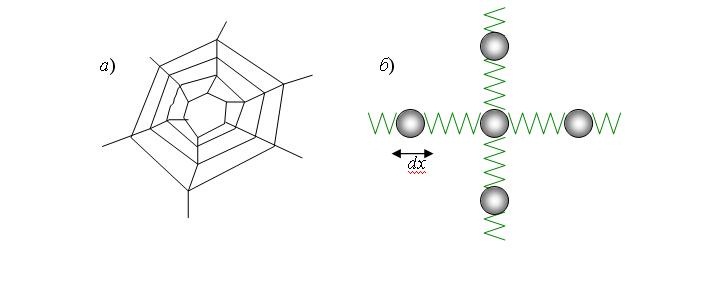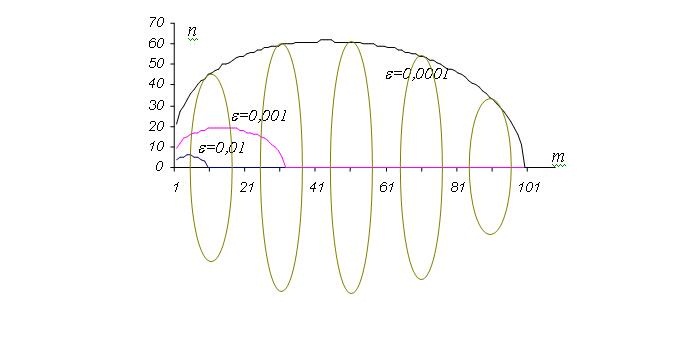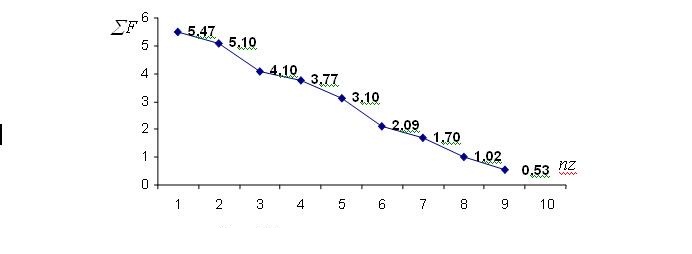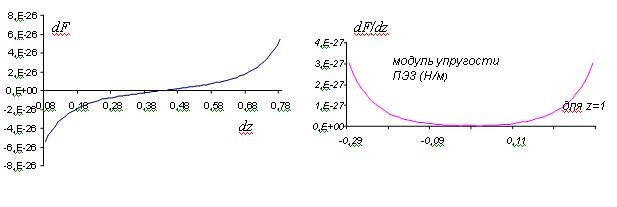
Fig. 1 Two schemes of Faraday structures
 (1),
(1),
so, in observed volume would be charge
 (2),
(2),
providing volumetric density of charge

The presence of electrical tension surely will force to move separate electrons, because of the fact that expulsive force will work on them.
 (3).
(3).The structure of the SEC turns out as scattering system of electrons, but the force that reduces(3) causes, on considerable distance from the source, a negligible velocity of the scattering. However, in an area dS, perpendicular to the motion vector, this force will generate a current which can be measured.
Procedures for the experimental determination of the intensity of the flow are described in detail [3] and we have to give its numerical value, which is on the Earth's surface was found to be
 .
. It is time to get acquainted with the "user's" features of such a space. As the most important characteristic of SEC we should recognize the elasticity module of the structure as a response of the structure to the force applied to a single electron. Identify them - has been quite challenging because of "collectivism" of an infinite number of charges. We had to go by limiting the considered volume by the criterion of the margin of error of calculations.
If we draw a cross section through SEC throug a test charge, then, mentally throwing one half, we obtain the pushing effect of the remainder of the charges on the test charge
 (4).
(4).Exactly such an effort senses every charge in the structure of SEC. But how to calculate the value of this force with an infinite number terms of sum? To go to the final values of forces, we denote the Coulomb force of interaction between adjacent charges as one.
 (5).
(5).
Fig. 2 The action of system of charges on test charge
 (6).
(6).And asking ourselves about permissible relative error
 , limiting initially ordinal
number of charge on x axis
, limiting initially ordinal
number of charge on x axis  , and then - on у axis
, and then - on у axis (7).
(7).Thus, we have limited the consideration of charges, contributing less than that. Family of boundary curves for = 0.01, 0.001 and 0.0001, forming in space an imaginary body of rotation, is shown in Figure 11.

By calculating the sum of the forces of interaction between charges of limited space, we compare the pairs of values - of the relative error andof the sum of forces acting on the charge. The approximate value of this row for arbitrary error is achieved by function
 (8).
(8). (8).
(8).An equally important parameter is the SEC elasticity modulus of connection of the test charge with all the grid of SEC. It can be defined only for one of the spheres as a derivative
 (9).
(9).Оптимальная из сфер на рис.3 представляется в этом случае условными зарядами, расположенными на главном перпендикуляре по узлам решетки ПЭЗ, а величины их зарядов пропорциональны сумме сил в отдельном слое тела вращения (рис.4 ).
The optimal sphere in Figure 3 shows in this case by the conventional charges located on the main perpendicular to the lattice sites, SEC, and the values of their charges are proportional to the sum of the forces in a single layer of body rotation (Fig. 4).

Adding the increments dz to the position of the test charge, we find the increment of the emerging force of interaction (Fig. 5), aimed at stabilizing the situation of a test charge in the structure of SEC. The right figure shows a graph of the derivative - modulus of elasticity of SEC.
It is clear that for the movement of a test charge relative to the structure of SEC by more than on 0,25 z, there is need of considerable work to do. At the same time, for the vibrations of a test charge with an amplitude of less than 0,1 z, this work is practically equal to zero.

If we consider that in the air module SEC is only 0.7 nm, it becomes clear that the structure of the SEC practically does not allow high-frequency oscillations, as it is very effectively resists to acceleration.
Bibliography
1. Maxvell D.K. A Treatise on Electricity and Magnetism.v.1. M., Nauka. 1989.
2. A.D.Rudnev., V.F.Laptev. Teoria transformatora (The theory of transformator). Nuansi ili aisberg (Nuances or an iceberg? In compilation of writings "Sovremennie problemi nauki". (Modern problems of science) Edition1., edited by. academician RANS Zivluk U.N., "Kniga. Prosveschenie. Miloserdie" (Book Education Charity)., М.., 1999.
3. Zivluk U.N., Rudnev A.D., Laptev V.F. "Opisanie i resultati eksperimentа po registracii zariadovoi strukturi prostranstva i izmereniu gravitazionnih konstant Zemli". (Description and results of experiment on registration of charge-transfer structure of space and measurement gravitational constants of the Earth) М., 2001.
